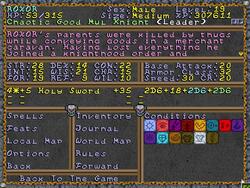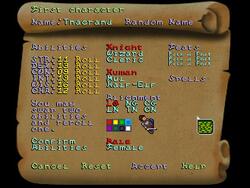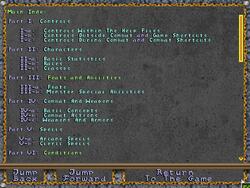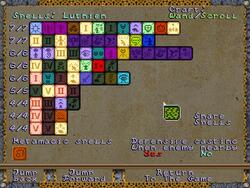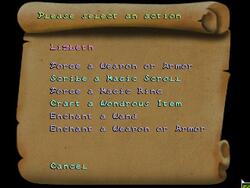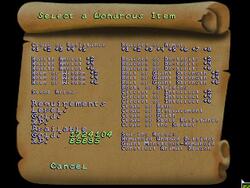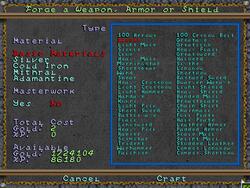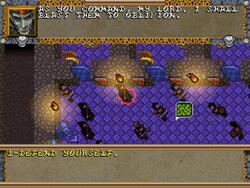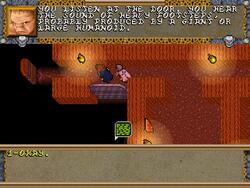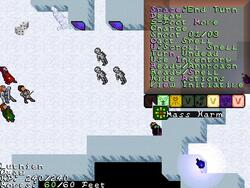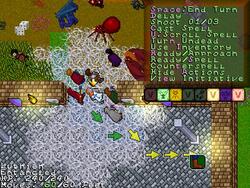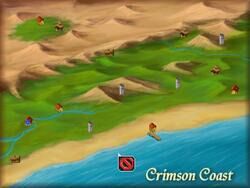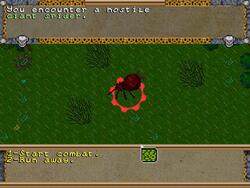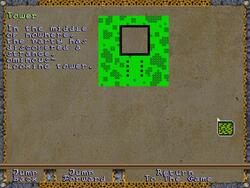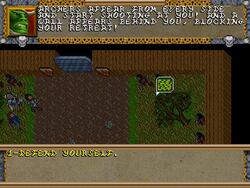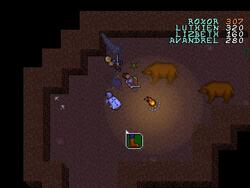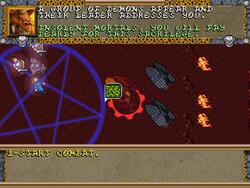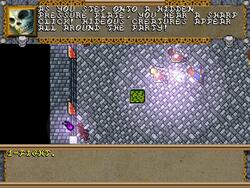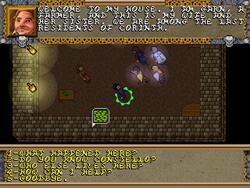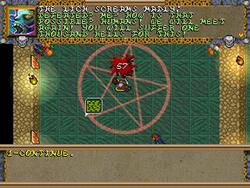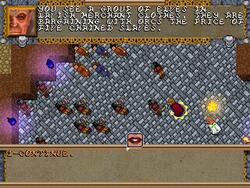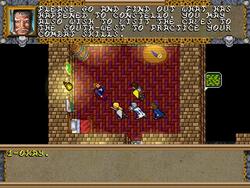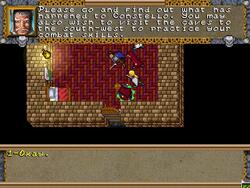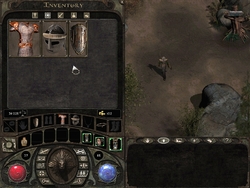Knights of the Chalice – A Heroic Fantasy Adventure
Knights of the Chalice – A Heroic Fantasy Adventure
Review - posted by DarkUnderlord on Sun 5 September 2010, 03:54:27
Tags: Heroic Fantasy Games; Knights of the ChaliceDarth Roxor takes a look at Knights of the Chalice, that turn-based indie D&D game which has been known to rape the less experienced:
But is the game fun? Read the rest to find out.
Next thing that deserves mentioning is the enemy AI, as it really is top notch. It adapts to your party tactics and line-up well, effectively uses spell combinations and abilities. For example, is everyone in your party engulfed in web? You’re bound to have a fireball going your way to achieve extra fire damage. Some of your party members are protected by death ward? Archers with slaying arrows will be less likely to target them. It’s also common for pretty much your whole party to be completely disabled, due to good choosing of priorities and abilities among the enemy. The knight? Grappled and pinned by a giant. Wizard? Counterspelled. Cleric? Three archers are ready against his casting of spells. Second knight? Charmed. Have fun, you’re doomed.
But is the game fun? Read the rest to find out.
Review by Darth Roxor
Overview
Knights of the Chalice is an independent old school RPG in, perhaps, its purest form. Developed by Heroic Fantasy Games, the focus here is on dungeon crawling, combat, fighting, violence, brawling and the occasional slaughter. Forget your fancy graphics and shameless ‘choose your own adventure’ RPGs – a mammoth of party-based D&D combat is coming your way.
Ready the army
Starting the game, we’re greeted by a cheesy MIDI tune and the screen shown above. After that, we land in the main menu, and can choose to start the game. Character creation is pretty straightforward – first, you roll your character’s attributes. You can re-roll one stat and swap the values of two others to fit your vision better. After that, you choose your class (there are only three –knight, cleric and wizard) pick feats and, where necessary, spells and choose your race. There are three races – Human (the all around race with no bonuses or penalties), Mul (half-dwarf kind of thing, has +2 strength, but –2 dexterity) and Half-Elf (+2 intelligence/dexterity at the price of –2 strength/constitution). After that come the, cosmetic only, choices of alignment, gender and colour of clothing/armour. You create four characters which are limited to level 20. Afterwards, you’re asked whether you want to play the ‘ironman’ mode (no saving, game over means no second chances) and you can start the game.
What is amazing and deserves the highest praise, is the ‘help’ menu, that can be seen in the character creation screen. Basically, it’s an in-game manual. It’s available at all times, either by hitting F1 or right-clicking something, and, truth be told, it has information about everything. To be honest, when I approached the game, I didn’t really have too big of an idea about 3.5 edition D&D combat and all its features like grappling, attacks of opportunity, etc, but they’re all described there in a pretty clear way, so quickly understanding the mechanics was no problem for me. It also acts as a D&D reference book, listing all kinds of spells, effects, monster types and their weaknesses, etc.
There are already two flaws made apparent after character creation. First is the lack of skills. That’s right, there are no dialogue rolls, like diplomacy or intimidate, crafting is down to just the feats, lore is out (so is the ‘identify’ spell – all items come already identified), forget about hiding, opening locks or disabling traps. The only ‘skill’ left is concentration, and it’s calculated as 1d20 + caster level + constitution modifier. Second flaw are the classes. Three classes don’t even meet the ‘standard fantasy party’ expectation due to the lack of a rogue character, not to mention that it considerably increases carelessness because of the absence of traps.
Also, while discussing classes, spellcasters should be addressed. They’re don’t work exactly like in normal 3.5ed. Both clerics and wizards are something like a cross between a wizard and a spirit shaman. That is, both don’t need to memorise spells – they’re casting from a ‘pool’ (as in, if you have three level three spell slots, you can use three prayers or three cure moderate wounds or combinations of these as you see fit). Both can learn spells from scrolls, and both gain new spells at each level up. As you can see, the only thing that really makes clerics ‘clerics’ is the divine magic. Heck, before one patch they didn’t even have Turn Undead.
Generally, the lack of many options during character creation gimps the replay value a little, since the only other options you can try on each playthrough are just differences in how many characters of certain class are in your party or what weapon your knight uses.
Also, it is important to note that the classes are pretty imbalanced, mostly due to a poor choice of spells. There might be no choice of difficulty per se in Knights of the Chalice, but the party you create will great influence the problems you shall face during the game. My first playthrough was with a party of two knights (swordsman and archer), a cleric and a wizard. Generally, it was hell on earth. During the second one, though, I decided to take two wizards, one axeman knight and a cleric. Piss-easy describes it well.
Why did this happen? It might be partly because during the second playthrough I had ‘metagame knowledge’ of certain encounters, but the main reason was the different party formation. Due to the lack of spell memorisation, you don’t really need to plan ahead what spells your wizards should take. While with only one you still have to somewhat conserve your spell reserves and you can cast only one spell per turn, with two you can just spam fireballs like there’s no tomorrow, and there’s still the auxiliary artillery, even if one of them happens to die. During the first playthrough, I also couldn’t help but notice how underpowered the archer was in relation to the swordsman, since the areas in which you fight are generally small, so the distance advantage is smaller. You also can’t have magic arrows with effects other than sleep and slaying, although bows can be enchanted with various upgrades, which evens it out a bit.
Slaying arrows are also a neat gimmick (if a monster of the type to which the arrow is assigned doesn’t pass a fortitude check, it dies instantly), but later on, when you meet very high leveled monsters with saving throws going to the stratosphere, they lose their effectiveness. And finally, we come to the miserable, neutered clerics… While they got a few slight buffs in a couple of patches (Turn Undead is one, second is the ability to use mass-heal spells to harm undead, which wasn’t possible before), they’re still pitiful. For starters, you can’t choose a cleric’s domain, which already removes access to some neat combat spells. The choice of spells for the cleric is downright horrible. They have maybe four offensive spells (sound burst, firestorm, searing light, magic stone) other than inflict wound spells. What happened to glyph of warding? Flame strike? Castigate? Well, then you probably think they’re good for buffing/supporting. THINK AGAIN!
Of the spells that give mass bonuses to attack rolls/saving throws/AC there’s only bless, prayer and mass protection from evil. Forget about chant, forget about recitation, forget about holy aura, instead you have all manner of useless stuff like protection from acid. In melee, they are also pretty pathetic, even with all the various righteous mights and divine powers they have. So what are clerics actually good for? Being the party’s healbot. And nothing else, really. It’s also pretty unfortunate that summon monster or planar ally spells are not present, even though you can summon elementals at level 1, so summoning is not impossible. While wizards also have their share of useless spells, it doesn’t matter as much because they have the most important stuff, anyway – maximised fireball/cone of cold/freezing sphere, etc.
While on the subject of imbalanced things, crafting is overpowered to the point of being broken. To craft an item, you need four to five things: the corresponding feat, the required character level, certain amounts of gold and experience to sacrifice and a masterwork item if you’re enchanting a piece of armour or a weapon. Gold isn’t really an issue, and if you spread the crafting feats across all characters, the xp penalties aren’t that serious either. You don’t need any recipes, so the moment you get the needed level, you can craft a +5 vorpal blade of absolute destruction. Combat encounter giving you problems? No matter! Just craft a gazillion of proper slaying arrows and maybe a wand of fireball if you’re running out of spells. To forge a weapon or suit of armour out of certain material, like mithral, you also don’t need neither a recipe nor even the material itself. Only gold and experience.
Crafting is inventory-related, so let’s give this a few words too. There is space for sixteen items in your backpack and encumbrance is out, which may bother some folks, but personally, I didn’t mind it. At least I could carry around dozens of sets of plate armour that I could sell for lots of shiny gold. My only complaint is that during the course of the game you find lots of ‘letters’, which are basically plotpushers, and they tend to clog up your inventory because you’re not quite sure if they’ll become important later, and are too afraid to part with them. Sending them to the journal or something would have been better.
In battle there is no law
Your party are the Knights of the Chalice, members of the order of knights devoted to finding the Holy Chalice. One of your battle brothers is kidnapped. Your keep is attacked by unknown offenders. You must discover and stop the tide of evil spreading through the kingdom!!!!
Damn, this sure sounds banal, now doesn’t it? Fortunately, though, it’s completely irrelevant. The clichéd plot is nothing but a way to send you from dungeon to dungeon, and these dungeons are very well designed. Of course, there’s not much to do there except for fighting through hordes of enemy forces, but it never gets old due to a couple of factors.
First is encounter design. Most of you who played Temple of Elemental Evil are probably emotionally scarred to this day and get Vietnam flashbacks each time they see a group of bugbears. This is, fortunately, not the case here. Mobs of enemies of a single type (like for example, a group of skeletons) are extremely rare, and even when they appear, they usually aren’t repeated more than once for the next few hours. Moreover, enemy parties are mixed very well, so finding wizards, clerics, archers (often with slaying arrows!) and creatures with spell-like abilities all in one encounter is not uncommon. Furthermore, there are many instances of enemies surprising you, be it due to you falling into their trap, or because of them dropping right on your head.
A good example is the final encounter of the Orc Stockade, which is used as a base of operations for the slavers working in the land. When you leave it, you’re ambushed by a group of what could be described as Epic Gnolls. You’re surprised, which means they all have a free turn before you can do anything. There are about eight or ten of them, among them fighters, wizards who polymorph into giant spiders right after barraging you with web and other offensive spells, and clerics who keep pestering you with bane and prayer.
But that is not to say only monsters can ambush you. By taking certain precautions where possible, you can use the element of surprise against them as well. Apart from scripted things, like ‘you enter the room and find a bunch of unsuspecting enemies’, it is possible to listen through closed doors. Often, this will give you information about what to expect on the other side, and many times you’re given the option to open the door normally or barge in violently to gain the upper hand.
Another example from the Orc Stockade: you meet a slaver there, who says that he’s not too keen on dying, and if you promise to let him go, he’ll give you some information. If you agree, he says there is a dragon a few rooms ahead, and reveals to you the location of some dragon slaying arrows. Then you can either kill him or let him go. If you let him go, he shares another secret with you while leaving. The next door is rigged with something that does a lot of noise and is supposed to be a signal to a group of mages waiting in the passage. If you open the door carefully and ‘disarm’ it, the mages won’t be expecting you.
Another good precaution is having a set of weapons from different materials on your knight, although that is mostly because of two enemies: babau and iron golems. Babau are quite possibly the nastiest bastards you’ll be meeting in the game – demons with spell resistance, immunities or resistances to almost all kinds of damage, acid shield in melee, weakness only to cold iron. Iron golems, however, are overpowered due to the poor choice of spells. Their only weaknesses are lightning and acid, right? For wizards, the only lightning spell is lightning bolt (funny thing, there’s also discharge, which would do perfectly… but KotC doesn’t allow you to use it on iron golems. Why? Just because, although it might be due to the golems' immunity to stun), and three acid spells are acid ray (which is pathetic), rusting grasp (decent, but touch-ranged, which makes your wizard vulnerable) and acid blast (which is a level 9 spell, and you might prefer to save those). Clerics can only throw searing light at them. As for monster variety, my only complaint is that, later on, there are just too many dragons. Almost every second fight has one or two, which is ridiculous.
Moving on, the combat interface also deserves approval. It’s very clear and convenient. Every action has a hotkey assigned to it, and they are always visible on the screen, which means you don’t have to dig through hundreds of clunky wheel menus (I’m looking at you, ToEE). Charge attacks are initiated automatically when engaging from a distance, so is coup de grace against paralysed opponents. Characters also often use 5 foot step on their own to get to hit modifiers from flanking. A list of recently used spells is visible under the action window if you don’t want to access the magic screen each time you wish to drop a fireball. When using damaging spells, the average damage or immunities on affected creatures is also shown.
Next thing that deserves mentioning is the enemy AI, as it really is top notch. It adapts to your party tactics and line-up well, effectively uses spell combinations and abilities. For example, is everyone in your party engulfed in web? You’re bound to have a fireball going your way to achieve extra fire damage. Some of your party members are protected by death ward? Archers with slaying arrows will be less likely to target them. It’s also common for pretty much your whole party to be completely disabled, due to good choosing of priorities and abilities among the enemy. The knight? Grappled and pinned by a giant. Wizard? Counterspelled. Cleric? Three archers are ready against his casting of spells. Second knight? Charmed. Have fun, you’re doomed.
Although it needs to be said that some of the stuff is screaming ‘scripts!’. For example, in another fight with epic gnolls, the first thing one of their wizards always casts is insect swarm. In another fight with a dragon cult, the lead cleric always uses his first turn to cast death ward on the dragon, etc. Also, sometimes the AI gets wonky and can be easily abused due to persistent area effects. It seems that the AI has it coded to always use bull rush on characters that are on the edge of webs or standing next to fiery braziers to push them into it. While it sounds clever on paper, the braziers do only 20 damage, and I’ve seen giants with three attacks, each doing about 35 damage wasting their turns bull rushing characters.
Monsters usually reside in dungeons and other godforsaken hellholes, so let’s give them some coverage. You travel to them on an overland map with some remarkably silly music. The map also has random encounters, but I felt they were done just to be there because that’s what people expect. You meet all kinds of random enemies, from gnolls through evil elves and giants to even vrocks and dragons, which is a little overkill. When facing such an encounter, you get the option to fight or run away. In the options menu you can set whether running away should have a chance to fail or not, or even disable the encounters all together.
There are many different dungeons in the game, mostly mandatory, but three are optional. There are fortresses for three types of giants (hill, ice, fire), each with attributes characteristic to their respective inhabitants, there’s an orc fortress, a tower full of undead, some caves and crypts, etc. The mandatory dungeons are set up in a linear fashion, that is, you won’t visit the ice giant fortress before going to the hill giant one, as the key to it is hidden there, even though all the dungeons are available at once on the overland map. All of them have some interesting scenarios or subquests in them.
For example, there is a cave full of thri-keens, intelligent insectoids. Their leader tells you, that they are oppressed by dwarves living nearby. You can agree to help them reason with the dwarves. When you arrive in the dwarf keep, you’re taken to the king, who offers to reward you if you genocide the thri-keens. If you disagree or attempt diplomacy, you’re accused of espionage and thrown into prison. There, you’re visited by a high wizard of the dwarves, who tells you the king has gone mad, and eliminating him is the only way to restore order. You can disagree, kill the dwarf, take the cell key and escape or agree and assault the king.
Once he’s dead and you report to the thri-keen leader, he gives you the key to a crypt with some neat stuff inside. You may also come upon a village mind controlled by a dragon residing below the town’s temple. When you finally meet the dragon, he engages in dialogue, saying that you would do better to serve him. If you waste time on idle chit-chat, he manages to call in reinforcements. Attacking at once never makes them come. Alternatively, exploring the cave, you may find an underground river with zombie workers pumping the water out. If you kill the zombies, the river overflows and floods the rest of the cave, which effectively kills the ‘boss’ dragon. It makes you miss out on some experience and loot, though. Only thing I would like to see more of, however, are puzzles or riddles. I think there are maybe two in the whole game.
Towns come in various sizes, from small villages to big cities, but they’re mostly related to the main quest. There are merchants in every city, sure, some sidequests too, but they’re mostly just assortments of houses full of NPCs that don’t initiate any, even flavour, dialogue.
Also, many of the dungeons have a very, very mean mechanic that cuts off your escape route. This is especially mean due to the fact, that you cannot rest everywhere, only at certain campfire spots, and these are rather rare. When trapped inside such a dungeon of no return, you need to conserve your supplies very strictly, or you will find yourself in a bossfight with no spells, scrolls or slaying arrows left (bonus points if you’ve never taken any crafting feats), which is a perfect recipe for disaster.
In many places, there are various ‘triggers’ that make enemies appear all around you. Sometimes, they’re pretty obvious, like a giant pentagram in the centre of the room or a motionless gorgon next to a switch opening a passageway, but there are times when you are navigating through a cave when all of a sudden, the floor collapses and you fall right into enemy hands. Generally, it’s good to apply the golden rule of expecting the worst when entering a large hall that seems empty, but this is hampered a bit by the inability to prebuff. Indeed, all these defensive spells like prayer, haste, mage armour, etc cannot be cast outside combat. This may be a little irritating sometimes, especially before obvious fights, but it does remove the ‘heck, I’ll just reload, use the gazillions of enchantments I have and go in guns blazing’ attitude. It also makes you set priorities well and leads to some tense gambles: should you launch stoneskin first to decrease damage or maybe haste to enable a tactical retreat and generally make your party operate better? Decisions, decisions…
Tactical data
You would probably want to read a little about things like writing or quest design. Well, I think just saying ‘it’s there’ is enough. It’s mostly just functional dialogue, although what especially has fallen into my memory is the ‘make your prayers’ line, which seems to be thrown around by nearly every monster or slaver or bandit or whatever in existence.
While there are no skill checks in dialogues, it doesn’t mean that choosing replies doesn’t matter at all. There are several instances where proper dialogue options allow you to skip combat or gain additional benefits. For example, at the end of the Orc Stockade, you find elves bargaining for slaves with the orcs. You can convince the elves to help you fight the greenskins. Moreover, there are many moments, where the enemies try to bluff you in order to launch a surprise attack or call reinforcements.
Quest design is pretty straightforward. The main quest is a typical string of uncovering facts about evil people that want to enslave the land, and side quests usually just boil down to ‘bring me a macguffin’ or ‘please slaughter the evil invaders’.
There’s not much to say about the technical side of the game. Graphics are just as you can see them on the screenshots, that is, minimal. But even though they’re ‘old’, I wouldn’t really call them ‘ugly’. The lively colours are pleasant to look at, and some moderate lighting effects bring additional flavour. There’s also a day and night cycle, but it’s purely cosmetic. The top-down perspective may remind you of the Ultima or Darksun games. Everything is pretty polished, and I don’t remember encountering any bugs. Only thing I’d gladly see are bigger resolutions because the default one does feel small.
Music in Knights of the Chalice is limited to a few looped MIDI tracks assigned to various locations. I thought they weren’t bad, but I guess some folks may find them irritating, especially their looped nature.
As you may have noticed, some of the screenshots have different a font. It was changed in one of the patches, since people complained the original had been hard on the eyes, but personally, I didn’t really mind it, and I think it was better. Fortunately, you can choose which one you prefer. Here’s a comparison of the same dialogue window with both fonts, so you can compare for yourself.
And yes, patches… The support this game has been getting from the developer is also commendable. Tons of tweaks have been released, and, in fact, it is highly possible that some of the complaints I have filed in this very review have already been fixed.
Where next to conquer?
All in all, Knights of the Chalice is a very solid production. Some might accuse it of being just a combat engine, without trying to achieve anything else. Others might be put off by the dated graphics and lack of art deco latrines. However, I’ve had lots of fun with this game, and I’m definitely going to return to it more than once, despite its flaws. It is easily the best use of third edition D&D combat in the history of computer RPGs, and the best RPG since Wizardry 8. Apparently, the sequel is already planned, or even in the works, and it promises an expanded list of classes and races, so I’m keeping my fingers crossed for Heroic Fantasy Games. Salute and ride on!
Overview
Knights of the Chalice is an independent old school RPG in, perhaps, its purest form. Developed by Heroic Fantasy Games, the focus here is on dungeon crawling, combat, fighting, violence, brawling and the occasional slaughter. Forget your fancy graphics and shameless ‘choose your own adventure’ RPGs – a mammoth of party-based D&D combat is coming your way.
Ready the army
Starting the game, we’re greeted by a cheesy MIDI tune and the screen shown above. After that, we land in the main menu, and can choose to start the game. Character creation is pretty straightforward – first, you roll your character’s attributes. You can re-roll one stat and swap the values of two others to fit your vision better. After that, you choose your class (there are only three –knight, cleric and wizard) pick feats and, where necessary, spells and choose your race. There are three races – Human (the all around race with no bonuses or penalties), Mul (half-dwarf kind of thing, has +2 strength, but –2 dexterity) and Half-Elf (+2 intelligence/dexterity at the price of –2 strength/constitution). After that come the, cosmetic only, choices of alignment, gender and colour of clothing/armour. You create four characters which are limited to level 20. Afterwards, you’re asked whether you want to play the ‘ironman’ mode (no saving, game over means no second chances) and you can start the game.
What is amazing and deserves the highest praise, is the ‘help’ menu, that can be seen in the character creation screen. Basically, it’s an in-game manual. It’s available at all times, either by hitting F1 or right-clicking something, and, truth be told, it has information about everything. To be honest, when I approached the game, I didn’t really have too big of an idea about 3.5 edition D&D combat and all its features like grappling, attacks of opportunity, etc, but they’re all described there in a pretty clear way, so quickly understanding the mechanics was no problem for me. It also acts as a D&D reference book, listing all kinds of spells, effects, monster types and their weaknesses, etc.
There are already two flaws made apparent after character creation. First is the lack of skills. That’s right, there are no dialogue rolls, like diplomacy or intimidate, crafting is down to just the feats, lore is out (so is the ‘identify’ spell – all items come already identified), forget about hiding, opening locks or disabling traps. The only ‘skill’ left is concentration, and it’s calculated as 1d20 + caster level + constitution modifier. Second flaw are the classes. Three classes don’t even meet the ‘standard fantasy party’ expectation due to the lack of a rogue character, not to mention that it considerably increases carelessness because of the absence of traps.
Also, while discussing classes, spellcasters should be addressed. They’re don’t work exactly like in normal 3.5ed. Both clerics and wizards are something like a cross between a wizard and a spirit shaman. That is, both don’t need to memorise spells – they’re casting from a ‘pool’ (as in, if you have three level three spell slots, you can use three prayers or three cure moderate wounds or combinations of these as you see fit). Both can learn spells from scrolls, and both gain new spells at each level up. As you can see, the only thing that really makes clerics ‘clerics’ is the divine magic. Heck, before one patch they didn’t even have Turn Undead.
Generally, the lack of many options during character creation gimps the replay value a little, since the only other options you can try on each playthrough are just differences in how many characters of certain class are in your party or what weapon your knight uses.
Also, it is important to note that the classes are pretty imbalanced, mostly due to a poor choice of spells. There might be no choice of difficulty per se in Knights of the Chalice, but the party you create will great influence the problems you shall face during the game. My first playthrough was with a party of two knights (swordsman and archer), a cleric and a wizard. Generally, it was hell on earth. During the second one, though, I decided to take two wizards, one axeman knight and a cleric. Piss-easy describes it well.
Why did this happen? It might be partly because during the second playthrough I had ‘metagame knowledge’ of certain encounters, but the main reason was the different party formation. Due to the lack of spell memorisation, you don’t really need to plan ahead what spells your wizards should take. While with only one you still have to somewhat conserve your spell reserves and you can cast only one spell per turn, with two you can just spam fireballs like there’s no tomorrow, and there’s still the auxiliary artillery, even if one of them happens to die. During the first playthrough, I also couldn’t help but notice how underpowered the archer was in relation to the swordsman, since the areas in which you fight are generally small, so the distance advantage is smaller. You also can’t have magic arrows with effects other than sleep and slaying, although bows can be enchanted with various upgrades, which evens it out a bit.
Slaying arrows are also a neat gimmick (if a monster of the type to which the arrow is assigned doesn’t pass a fortitude check, it dies instantly), but later on, when you meet very high leveled monsters with saving throws going to the stratosphere, they lose their effectiveness. And finally, we come to the miserable, neutered clerics… While they got a few slight buffs in a couple of patches (Turn Undead is one, second is the ability to use mass-heal spells to harm undead, which wasn’t possible before), they’re still pitiful. For starters, you can’t choose a cleric’s domain, which already removes access to some neat combat spells. The choice of spells for the cleric is downright horrible. They have maybe four offensive spells (sound burst, firestorm, searing light, magic stone) other than inflict wound spells. What happened to glyph of warding? Flame strike? Castigate? Well, then you probably think they’re good for buffing/supporting. THINK AGAIN!
Of the spells that give mass bonuses to attack rolls/saving throws/AC there’s only bless, prayer and mass protection from evil. Forget about chant, forget about recitation, forget about holy aura, instead you have all manner of useless stuff like protection from acid. In melee, they are also pretty pathetic, even with all the various righteous mights and divine powers they have. So what are clerics actually good for? Being the party’s healbot. And nothing else, really. It’s also pretty unfortunate that summon monster or planar ally spells are not present, even though you can summon elementals at level 1, so summoning is not impossible. While wizards also have their share of useless spells, it doesn’t matter as much because they have the most important stuff, anyway – maximised fireball/cone of cold/freezing sphere, etc.
While on the subject of imbalanced things, crafting is overpowered to the point of being broken. To craft an item, you need four to five things: the corresponding feat, the required character level, certain amounts of gold and experience to sacrifice and a masterwork item if you’re enchanting a piece of armour or a weapon. Gold isn’t really an issue, and if you spread the crafting feats across all characters, the xp penalties aren’t that serious either. You don’t need any recipes, so the moment you get the needed level, you can craft a +5 vorpal blade of absolute destruction. Combat encounter giving you problems? No matter! Just craft a gazillion of proper slaying arrows and maybe a wand of fireball if you’re running out of spells. To forge a weapon or suit of armour out of certain material, like mithral, you also don’t need neither a recipe nor even the material itself. Only gold and experience.
Crafting is inventory-related, so let’s give this a few words too. There is space for sixteen items in your backpack and encumbrance is out, which may bother some folks, but personally, I didn’t mind it. At least I could carry around dozens of sets of plate armour that I could sell for lots of shiny gold. My only complaint is that during the course of the game you find lots of ‘letters’, which are basically plotpushers, and they tend to clog up your inventory because you’re not quite sure if they’ll become important later, and are too afraid to part with them. Sending them to the journal or something would have been better.
In battle there is no law
Your party are the Knights of the Chalice, members of the order of knights devoted to finding the Holy Chalice. One of your battle brothers is kidnapped. Your keep is attacked by unknown offenders. You must discover and stop the tide of evil spreading through the kingdom!!!!
Damn, this sure sounds banal, now doesn’t it? Fortunately, though, it’s completely irrelevant. The clichéd plot is nothing but a way to send you from dungeon to dungeon, and these dungeons are very well designed. Of course, there’s not much to do there except for fighting through hordes of enemy forces, but it never gets old due to a couple of factors.
First is encounter design. Most of you who played Temple of Elemental Evil are probably emotionally scarred to this day and get Vietnam flashbacks each time they see a group of bugbears. This is, fortunately, not the case here. Mobs of enemies of a single type (like for example, a group of skeletons) are extremely rare, and even when they appear, they usually aren’t repeated more than once for the next few hours. Moreover, enemy parties are mixed very well, so finding wizards, clerics, archers (often with slaying arrows!) and creatures with spell-like abilities all in one encounter is not uncommon. Furthermore, there are many instances of enemies surprising you, be it due to you falling into their trap, or because of them dropping right on your head.
A good example is the final encounter of the Orc Stockade, which is used as a base of operations for the slavers working in the land. When you leave it, you’re ambushed by a group of what could be described as Epic Gnolls. You’re surprised, which means they all have a free turn before you can do anything. There are about eight or ten of them, among them fighters, wizards who polymorph into giant spiders right after barraging you with web and other offensive spells, and clerics who keep pestering you with bane and prayer.
But that is not to say only monsters can ambush you. By taking certain precautions where possible, you can use the element of surprise against them as well. Apart from scripted things, like ‘you enter the room and find a bunch of unsuspecting enemies’, it is possible to listen through closed doors. Often, this will give you information about what to expect on the other side, and many times you’re given the option to open the door normally or barge in violently to gain the upper hand.
Another example from the Orc Stockade: you meet a slaver there, who says that he’s not too keen on dying, and if you promise to let him go, he’ll give you some information. If you agree, he says there is a dragon a few rooms ahead, and reveals to you the location of some dragon slaying arrows. Then you can either kill him or let him go. If you let him go, he shares another secret with you while leaving. The next door is rigged with something that does a lot of noise and is supposed to be a signal to a group of mages waiting in the passage. If you open the door carefully and ‘disarm’ it, the mages won’t be expecting you.
Another good precaution is having a set of weapons from different materials on your knight, although that is mostly because of two enemies: babau and iron golems. Babau are quite possibly the nastiest bastards you’ll be meeting in the game – demons with spell resistance, immunities or resistances to almost all kinds of damage, acid shield in melee, weakness only to cold iron. Iron golems, however, are overpowered due to the poor choice of spells. Their only weaknesses are lightning and acid, right? For wizards, the only lightning spell is lightning bolt (funny thing, there’s also discharge, which would do perfectly… but KotC doesn’t allow you to use it on iron golems. Why? Just because, although it might be due to the golems' immunity to stun), and three acid spells are acid ray (which is pathetic), rusting grasp (decent, but touch-ranged, which makes your wizard vulnerable) and acid blast (which is a level 9 spell, and you might prefer to save those). Clerics can only throw searing light at them. As for monster variety, my only complaint is that, later on, there are just too many dragons. Almost every second fight has one or two, which is ridiculous.
Moving on, the combat interface also deserves approval. It’s very clear and convenient. Every action has a hotkey assigned to it, and they are always visible on the screen, which means you don’t have to dig through hundreds of clunky wheel menus (I’m looking at you, ToEE). Charge attacks are initiated automatically when engaging from a distance, so is coup de grace against paralysed opponents. Characters also often use 5 foot step on their own to get to hit modifiers from flanking. A list of recently used spells is visible under the action window if you don’t want to access the magic screen each time you wish to drop a fireball. When using damaging spells, the average damage or immunities on affected creatures is also shown.
Next thing that deserves mentioning is the enemy AI, as it really is top notch. It adapts to your party tactics and line-up well, effectively uses spell combinations and abilities. For example, is everyone in your party engulfed in web? You’re bound to have a fireball going your way to achieve extra fire damage. Some of your party members are protected by death ward? Archers with slaying arrows will be less likely to target them. It’s also common for pretty much your whole party to be completely disabled, due to good choosing of priorities and abilities among the enemy. The knight? Grappled and pinned by a giant. Wizard? Counterspelled. Cleric? Three archers are ready against his casting of spells. Second knight? Charmed. Have fun, you’re doomed.
Although it needs to be said that some of the stuff is screaming ‘scripts!’. For example, in another fight with epic gnolls, the first thing one of their wizards always casts is insect swarm. In another fight with a dragon cult, the lead cleric always uses his first turn to cast death ward on the dragon, etc. Also, sometimes the AI gets wonky and can be easily abused due to persistent area effects. It seems that the AI has it coded to always use bull rush on characters that are on the edge of webs or standing next to fiery braziers to push them into it. While it sounds clever on paper, the braziers do only 20 damage, and I’ve seen giants with three attacks, each doing about 35 damage wasting their turns bull rushing characters.
Monsters usually reside in dungeons and other godforsaken hellholes, so let’s give them some coverage. You travel to them on an overland map with some remarkably silly music. The map also has random encounters, but I felt they were done just to be there because that’s what people expect. You meet all kinds of random enemies, from gnolls through evil elves and giants to even vrocks and dragons, which is a little overkill. When facing such an encounter, you get the option to fight or run away. In the options menu you can set whether running away should have a chance to fail or not, or even disable the encounters all together.
There are many different dungeons in the game, mostly mandatory, but three are optional. There are fortresses for three types of giants (hill, ice, fire), each with attributes characteristic to their respective inhabitants, there’s an orc fortress, a tower full of undead, some caves and crypts, etc. The mandatory dungeons are set up in a linear fashion, that is, you won’t visit the ice giant fortress before going to the hill giant one, as the key to it is hidden there, even though all the dungeons are available at once on the overland map. All of them have some interesting scenarios or subquests in them.
For example, there is a cave full of thri-keens, intelligent insectoids. Their leader tells you, that they are oppressed by dwarves living nearby. You can agree to help them reason with the dwarves. When you arrive in the dwarf keep, you’re taken to the king, who offers to reward you if you genocide the thri-keens. If you disagree or attempt diplomacy, you’re accused of espionage and thrown into prison. There, you’re visited by a high wizard of the dwarves, who tells you the king has gone mad, and eliminating him is the only way to restore order. You can disagree, kill the dwarf, take the cell key and escape or agree and assault the king.
Once he’s dead and you report to the thri-keen leader, he gives you the key to a crypt with some neat stuff inside. You may also come upon a village mind controlled by a dragon residing below the town’s temple. When you finally meet the dragon, he engages in dialogue, saying that you would do better to serve him. If you waste time on idle chit-chat, he manages to call in reinforcements. Attacking at once never makes them come. Alternatively, exploring the cave, you may find an underground river with zombie workers pumping the water out. If you kill the zombies, the river overflows and floods the rest of the cave, which effectively kills the ‘boss’ dragon. It makes you miss out on some experience and loot, though. Only thing I would like to see more of, however, are puzzles or riddles. I think there are maybe two in the whole game.
Towns come in various sizes, from small villages to big cities, but they’re mostly related to the main quest. There are merchants in every city, sure, some sidequests too, but they’re mostly just assortments of houses full of NPCs that don’t initiate any, even flavour, dialogue.
Also, many of the dungeons have a very, very mean mechanic that cuts off your escape route. This is especially mean due to the fact, that you cannot rest everywhere, only at certain campfire spots, and these are rather rare. When trapped inside such a dungeon of no return, you need to conserve your supplies very strictly, or you will find yourself in a bossfight with no spells, scrolls or slaying arrows left (bonus points if you’ve never taken any crafting feats), which is a perfect recipe for disaster.
In many places, there are various ‘triggers’ that make enemies appear all around you. Sometimes, they’re pretty obvious, like a giant pentagram in the centre of the room or a motionless gorgon next to a switch opening a passageway, but there are times when you are navigating through a cave when all of a sudden, the floor collapses and you fall right into enemy hands. Generally, it’s good to apply the golden rule of expecting the worst when entering a large hall that seems empty, but this is hampered a bit by the inability to prebuff. Indeed, all these defensive spells like prayer, haste, mage armour, etc cannot be cast outside combat. This may be a little irritating sometimes, especially before obvious fights, but it does remove the ‘heck, I’ll just reload, use the gazillions of enchantments I have and go in guns blazing’ attitude. It also makes you set priorities well and leads to some tense gambles: should you launch stoneskin first to decrease damage or maybe haste to enable a tactical retreat and generally make your party operate better? Decisions, decisions…
Tactical data
You would probably want to read a little about things like writing or quest design. Well, I think just saying ‘it’s there’ is enough. It’s mostly just functional dialogue, although what especially has fallen into my memory is the ‘make your prayers’ line, which seems to be thrown around by nearly every monster or slaver or bandit or whatever in existence.
While there are no skill checks in dialogues, it doesn’t mean that choosing replies doesn’t matter at all. There are several instances where proper dialogue options allow you to skip combat or gain additional benefits. For example, at the end of the Orc Stockade, you find elves bargaining for slaves with the orcs. You can convince the elves to help you fight the greenskins. Moreover, there are many moments, where the enemies try to bluff you in order to launch a surprise attack or call reinforcements.
Quest design is pretty straightforward. The main quest is a typical string of uncovering facts about evil people that want to enslave the land, and side quests usually just boil down to ‘bring me a macguffin’ or ‘please slaughter the evil invaders’.
There’s not much to say about the technical side of the game. Graphics are just as you can see them on the screenshots, that is, minimal. But even though they’re ‘old’, I wouldn’t really call them ‘ugly’. The lively colours are pleasant to look at, and some moderate lighting effects bring additional flavour. There’s also a day and night cycle, but it’s purely cosmetic. The top-down perspective may remind you of the Ultima or Darksun games. Everything is pretty polished, and I don’t remember encountering any bugs. Only thing I’d gladly see are bigger resolutions because the default one does feel small.
Music in Knights of the Chalice is limited to a few looped MIDI tracks assigned to various locations. I thought they weren’t bad, but I guess some folks may find them irritating, especially their looped nature.
As you may have noticed, some of the screenshots have different a font. It was changed in one of the patches, since people complained the original had been hard on the eyes, but personally, I didn’t really mind it, and I think it was better. Fortunately, you can choose which one you prefer. Here’s a comparison of the same dialogue window with both fonts, so you can compare for yourself.
And yes, patches… The support this game has been getting from the developer is also commendable. Tons of tweaks have been released, and, in fact, it is highly possible that some of the complaints I have filed in this very review have already been fixed.
Where next to conquer?
All in all, Knights of the Chalice is a very solid production. Some might accuse it of being just a combat engine, without trying to achieve anything else. Others might be put off by the dated graphics and lack of art deco latrines. However, I’ve had lots of fun with this game, and I’m definitely going to return to it more than once, despite its flaws. It is easily the best use of third edition D&D combat in the history of computer RPGs, and the best RPG since Wizardry 8. Apparently, the sequel is already planned, or even in the works, and it promises an expanded list of classes and races, so I’m keeping my fingers crossed for Heroic Fantasy Games. Salute and ride on!
There are 56 comments on Knights of the Chalice – A Heroic Fantasy Adventure





